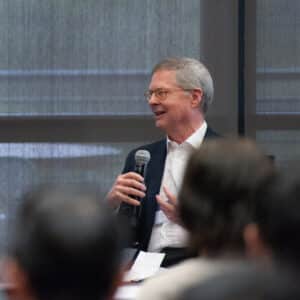Fred Clarke
Partner, Pelli Clarke & Partners
Age: 76
Industry experience: 55 years
A meeting with Argentine-American architect César Pelli during Fred Clarke’s student days at University of Texas-Austin led to a job offer and a long-time career alliance spanning until Pelli’s death in 2019. The New Haven, Connecticut-based architecture firm, Pelli Clarke & Partners, designs landmark skyscrapers that are changing the skylines of cities from Tokyo to San Francisco. One of its longest-running assignments is coming to fruition on Atlantic Avenue in Boston, at developer Hines’ South Station office-condominium scheduled for completion in 2025. The project is the latest in a series of transit-oriented developments designed by the firm, including 1,082-foot-tall Azabudai Hills Mori JP Tower under construction in Toyko and San Francisco’s Salesforce Tower which opened in 2018. This feature includes remarks by Clarke during a media tour of the South Station Tower as well as a follow-up interview.
Q: What were the challenges in keeping the South Station tower responsive to the market and project goals for more than two decades?
A: Twenty-five years ago, the assignment at South Station was to help expand the transit infrastructure, and frankly build an office tower above that. The assignment changed almost entirely over that period of time, but fortunately it kept moving. Twenty-five years ago, this was mostly an infrastructure problem: helping improve Amtrak service and bus service. South Station was not a happy place. Some of our assignment was to bring South Station back to life. Twenty-five years ago, this site was at the far edge of Boston. Today it’s at one of the centers of Boston.
Our first assignment was to nearly double the size of the bus station and bring the bus station into the center of gravity of South Station itself. Previously it was not at all. People in buses are kind of considered second-class citizens, and not as important as the people who arrive on Amtrak. Architecturally, you can unravel that and make the bus traveler equivalent to the train travelers.
Q: What are the major differences in designing buildings for U.S. clients versus international clients?
A: Working globally, you have to really educate yourself about the cultural differences between architecture in the U.S. and as it’s done practically anyplace else. There are some very big differences. In the U.S., a typical commercial office building floor plate is probably in the range of 25,000 to 28,000 square feet. In Japan, they can be as large as 50,000 to 60,000 square feet. We’re just finishing up a project in Tokyo that has a 65,000-square-foot footprint and it’s the tallest building in Japan. It’s really evidence of a vastly different real estate market and even building codes.
Those are the kind of differences you find in every country. It stems from tenant needs, attitudes about engineering and seismic issues, cultural differences, and even attitudes about daylight. When we work in Europe, floor plates are much smaller than the U.S. because in most countries, there are regulations about how far a person who is working in the building can be from sunlight. What I’ve learned in Japan is I’m not going to change how they do their work, so I have to change myself.
Q: Having designed projects in many global gateway cities, how does Boston’s architecture measure up?
A: The Boston Civic Design Commission is the one that watches out for architectural quality, and they have a very strong voice in Boston, stronger than in many cities that we work in, and they are all very bright and informed people. Frankly, that helps the process. I’m sympathetic to my clients because it’s an expense for them, but ultimately it results in a much better project.
Q: What led to your first job in the industry and the partnership with César Pelli?
A: I met César Pelli only once for a lecture when I was still a junior at the university, and we had a chance to talk. He looked at some of my projects. I didn’t know I was being interviewed, but then he went back to Los Angeles and wrote me a letter offering me a job. It’s the only career decision I ever made, and that was over 50 years ago. I feel very fortunate in that regard. He then left Los Angeles when he was named dean of the Yale School of Architecture, and I decided it was a good time for me to leave as well. I went to Rice University in Houston to teach.
He and I had a loose handshake arrangement that if any interesting projects came up, we could get together and create a firm. It happened very quickly. We landed the commission for the expansion and renovation of the Museum of Modern Art in New York, and I moved from Houston to Manhattan in one weekend. Over time, we created a firm in New Haven right near the Yale University campus, two blocks from the school of architecture, and we are in that same location 47 years later.
The story is in many ways a simple organic tale of just being lucky enough to find the right opportunities, but on the other hand, it’s been a lot of work and stress. I tell the younger people in my office if one considers the present moment and the economic slowdown, this is my sixth one. So just get through it, and the world will come back together at some point.
Clarke’s Five Favorite Films for a Long Holiday Weekend
- “High Fidelity”
- “Young Frankenstein”
- “Buckaroo Banzai”
- “Fifth Element”
- “Ghostbusters”





